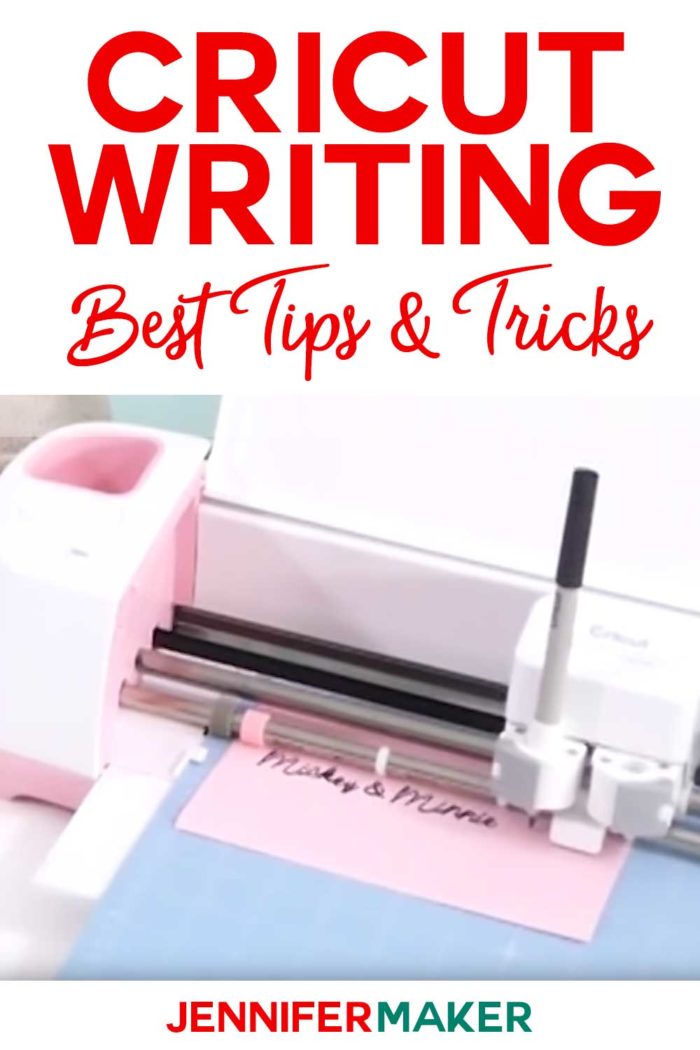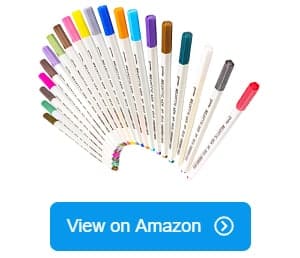
You get 10 dazzling colors in one pack that you can use for several art projects like scrapbooking, card-making, hand-lettering, and black-light illustrations. Since the inks do not bleed through paper, you can write on notebooks and journals with black pages. Additionally, this set is a child-friendly one as it meets the non-toxicity standards but adult supervision is encouraged.
You can use these pens on white paper, but they will work best if you apply them on black papers. Durable yet versatile, the tips are strong enough to handle the porous rock but they are also gentle on paper. What’s more, rendering with tips featuring a 1 mm ball produces a fairly consistent thickness of about 0.5 mm bold line.
Many people find the quality of white pen for black paper made by other brands looks so close to a white-out pen. After sampling them, I could see that the white releases gel ink that does not have the same effect as correctional fluid. On the other hand, the gold and silver pens beam on the dark surfaces like rocks.
They say, “The more, the merrier,” which is why this set of 20 metallic markers from Sunshilor landed on my review. Just like the 12-piece set, these markers that write on black paper will get your creative juices gushing. Without further adieu, let’s dive into the features.
4. Sakura Gelly Roll Moonlight Pen Set
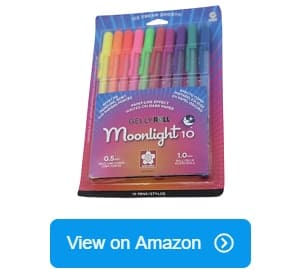
While you can write on different objects or papers, this brand categorized this product under scrapbook supplies. In addition, these markers are well-suited for black scrapbook pages. For instance, the 10 colors give me enough options to add decorative borders for the photos and mementos I attached.
Besides the outstanding attributes of the inks, the fine point tips is another reason that you should go for this one. These tips help me label dark objects like the black chargers of my gadgets. For creative purposes, I use them to make personalized greeting cards and embellish some artworks. I also find the colors go very well with the rustic-themed artworks but they are versatile and multipurpose.
Bright and metallic, all 12 colors shimmer on both light and dark backgrounds. Apart from paper, the inks also work well on fabric, ceramics, glass, wood, and metal. Moreover, both kids and adults are welcome to use these pens as the inks are water-based and acid-free.
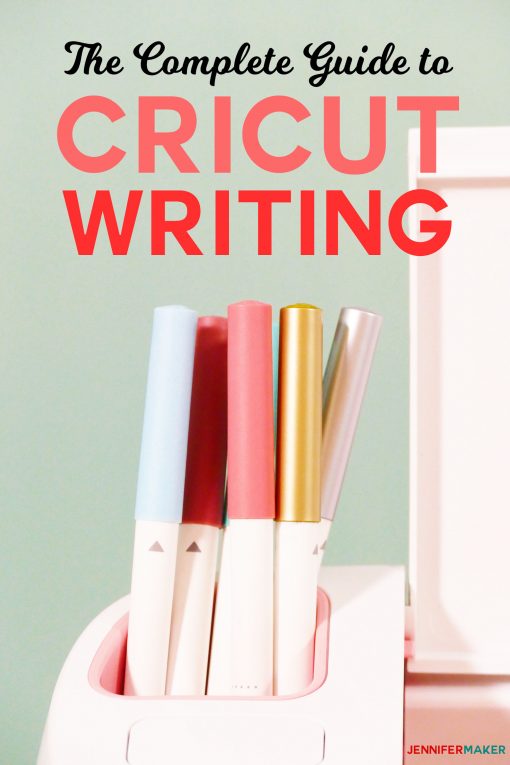
I’d love to see your project! If you make one, please share a photo in our Facebook group or tag me on social media with #jennifermaker.
When you’re ready, load your mat and press the Go button to begin writing. For my writing text, I set most of these pens to write in the same “writing” font called Dear John, which is a Cricut font that is a part of Cricut Access. The only two that aren’t in the Dear John font are the two calligraphy pens, which are in Emiline, also available with Cricut Access.
When you’re happy with your text, click Make It to send it to your Cricut.
Tip: Use the arrow on the front of your Cricut calligraphy pen as a guide and point it at the left corner of your drop-down front panel.
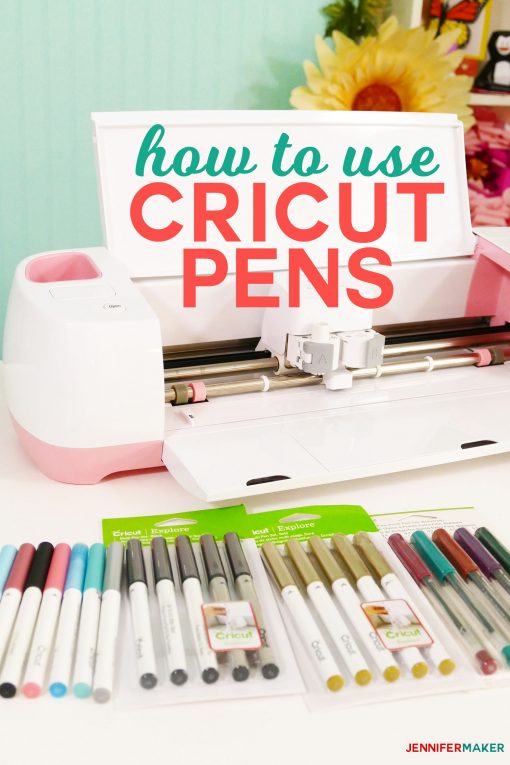
Select Pen Color: You can change your pen color by selecting the square in the toolbar by the Linetype box. A new Color Chooser panel will appear—just select a new color from this panel to set it.
Your Cricut comes with two tool clamps — clamp A and clamp B. Clamp A is for accessories, and this is where we can put pens. To insert a pen, simply open clamp A and insert the pen tip down while holding up on the bottom. If you’re inserting a Cricut pen, you’ll know it’s in place because you will hear it click and the arrow will disappear. Be sure to close the clamp once the pen is in.
One thing to note is that to get this pretty look with your Cricut writing, I used one of the advanced features of Design Space. I selected my text, clicked Advanced, and then chose “Ungroup to Letters.” This allowed me to move each letter individually so I could position it where it looked best. When done, just select all of the letters and click Attach.
When you’re ready, put an envelope on a cutting mat, load the mat, and press Go.

If you keep practicing at least 30 minutes every day there will be a moment where writing in straight, clean lines will become natural to you. Just practice and make a room for mistakes to happen and learn from them.
First, use the ruler and the black marker to make straight lines in the blank paper. After you’ve finished doing this, you are ready to go! You can then photocopy as many copies as you want to. Now all you have to do is grab one of the copies and place it behind a blank paper, then press down and you will see the lines become visible so you can start your writing, you can write with a pencil or an ink pen.
- Ink pen.
- Ruler.
- Blank Paper.
- Eraser.
- Pencil.
- Blank paper.
- Pencil or ink pen.
- Lined paper.
2. Using a Lined Paper Behind the Blank Paper

This method is used all over the world by the people that need straight lines and just don’t want to spend too much time doing so. It’s great if you need to write professional letters, as you will need an ink pen to do this. Technically, once you draw the lines — it won’t be unlined paper anymore.
With the help of the ruler and the pencil make straight lines on the blank paper. These lines have to be barely visible! Remember you’ll have to erase them after you write. Once you’ve placed your barely visible lines all over the blank paper, all you need to do is write your words over the lines with the ink pen and once you’ve finished just use the eraser to delete all the lines and have a blank paper with style and elegance.
At some point, as you keep doing this you will have to remove the guidelines and start writing on a simple blank paper. Write slow, this will give you time to get used it and to adjust your lines as you go, writing slow will also help you get cleaner and better phrases.
The best way to learn how to write in a straight line on blank paper is to practice a lot! This way you won’t need rulers, markers, erasers or extra pieces of paper. You can practice your handwriting and become a master at writing perfect straight lines.
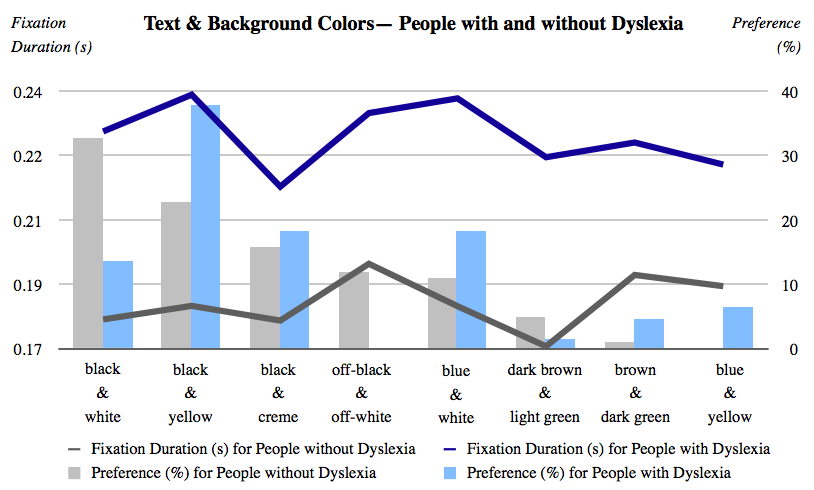
The role of colors in readability has been extensively discussed in relationship to dyslexia, a reading disability which occurs in around 10-17.5% of the English and 7.5-11.8% of the Spanish speaking population (Rello and Baeza-Yates, 2012). However, when reading the Web, poor colored text is one of the key problems encountered by people with dyslexia (McCarthy and Swierenga, 2010).
Our approach separates accessibility needs and personal preferences which are frequently mixed in the recommendations regarding colors and readability. Therefore, our tests were composed of two parts: (a) a set of texts to be read using eye-tracking to study the reading performance and (b) a questionnaire to collect the user preferences. Through this methodology we distinguish the aspects of text customization which allows readers with dyslexia to read more effectively and optional suggestions regarding their preferences. Each test was performed by 23 participants with dyslexia (Rello, Baeza-Yates and Kanvinde, 2012) and 92 participants without dyslexia (Rello and Marcos, 2012).
The W3C algorithm suggests to avoid brightness differences less than 125 and color differences less than 500. Our results are consistent with this threshold since the only pair which did not match the W3C algorithm (brown & dark green) presented high fixation durations for both groups (the second and the third highest for people without and with dyslexia, respectively) and were also hardly selected by the participants (4.55% for the participants without dyslexia and 0.99% for the participants with dyslexia). Surprisingly, the pair dark brown & light green which is very similar in terms of color hue but differ from the brown & dark green in term of brightness and color contrast presents the lowest and second lowest fixations duration for people with dyslexia and without dyslexia, respectively.
There are three weaknesses in our methodology which will be addressed in future experiments. First, the color pairs were presented in random order but not in a counter-balanced order. Therefore we cannot be certain if some of the results could be affected by the position of the textual fragment in the screen and if the preference data is biased by order effects. Second, the texts are too small to draw strong conclusions. Third, the texts were presented alone in the screen, thus we cannot predict the color effect in other reading contexts such as Web browsing.
1. Problem Description
The texts were presented to the participants to be read them in silence while they were recorded by the eye-tracker. Then, the participant filled a questionnaire regarding their personal preferences about the colors and their readability. The participants were trying to extract meaning from the text because they were expecting comprehension questions although the questionnaires were only about their preferences.
For the selection of the color pairs we took into consideration: (a) the previous literature, (b) the recommendations, (c) their frequency in the Web, and (d) their luminosity contrast ratio. The color pairs studied are given in Table 1.
In our study we empirically test previous recommendations and compare them with the W3C algorithm and the standard reading of a control group.
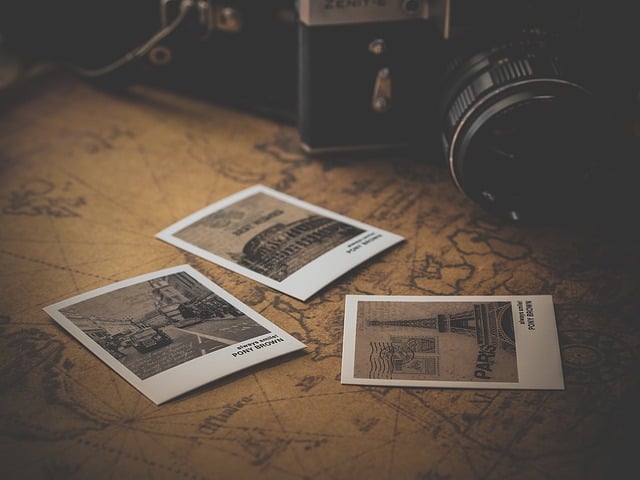
Sharpie has become one of the most famous marker pens because of its very satisfying and incredible writing performance. Sharpie markers have a firm tip that produces a quick flowing and also has a fast-drying ink.
Aside from ZIG Photo Signature Pen, there are also pens that are good for writing on photo paper such as Sharpie, Uni Pi:s and Zebra Mackee.
But the thing is if you will use this on a white color photo paper some colors were not that visible such as the green/yellow-green. They also offer Sharpie Metallic Fine Point Permanent Markers, they seem quite thick when you use this but they are not smudging at all they dry in an instant. This is good in designing your pictures like draw a crown, or effects because of the glimmering marks of the pen. Sharpie Metallic Fine Point Permanent Markers comes in 3 colors
But writing on photo paper can be frustrating sometimes because most of the time the pen you use to write on the picture would smudge or smear on the photo resulting in the photo to be ruined, and sometimes the ink would take a long time to dry.
Sharpies
The ZIG Photo Signature Pens are designed to write on the surface of modern plasticized photos and other shiny materials. The description also highlighted some of the ZIG Photo Signature Pen features, such as the pen having a precise, fine tip and photo-safe quick-drying inedible ink which would not smudge or smear on the surface (front or back) of modern plasticized photographs or any photo surface.
But most of these pens are not suitable for writing on photo paper. In choosing the right pen for the purpose of writing on a photo paper there are things that we should consider such as Finish, Tip size, Drying time, Acid-Free, Longevity, and Water-resistant.
Memories are created in every moment, some of these memories might be something you want to forget forever but still give you a slight chuckle of how stupid and embarrassing it was. Some might bring melancholy feeling whenever you reminisce it but brings a smile because alongside it is the happy memories. Such memories are best kept and shared with the people we care about. That is why one the best way for such memories to be kept and be shared is through photography.
The ZIG Photo Signature Pen is available online. It varies in price ranging from different prices depending on its seller. Some areas cheap as $1 but there are some people who sell it for $75.
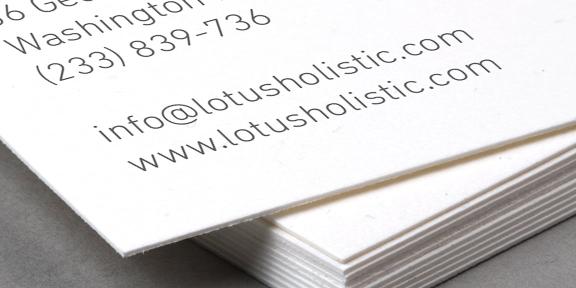
- 18pt, 100% cotton paper
- Naturally bright white
- Reuses fashion industry waste
- Uncoated, so you can write on it
- 80/100lb (matte/gloss) cover weight
- Matte looks natural and artisanal
- Gloss makes colors more vibrant
- Substantial feel. Bigger impact.
A heavy paper with silky finish this stock was chosen for its great print quality and luxurious, thick feel.
- 80lb. text weight / 6.2pt paper
- Sustainably sourced
- Satin smooth finish, designed for digital print
- Laser printer safe
MOO Super
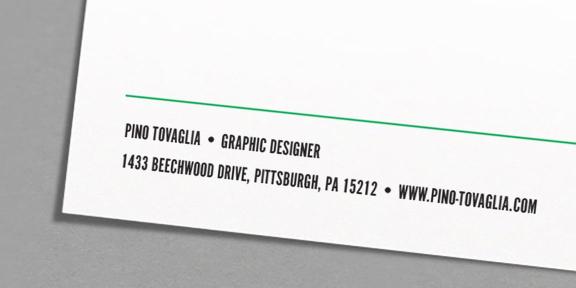
Our finest paper stock, using tactile and sumptuous Mohawk Superfine paper.
- 19pt premium paper
- Extra smooth finish makes cards ultra durable
- Available in two finishes: Soft Touch and High Gloss
- 110lb paper weight
- Dramatic metallic finish
- Eye-catching finish makes colors "pop"
- Weighty, keep-hold-of-me quality
- For special events and occasions

